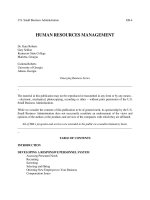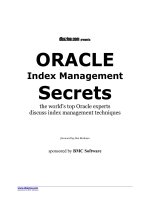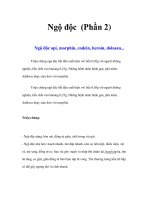Tài liệu E-Human Resource Management 2 pptx
Bạn đang xem bản rút gọn của tài liệu. Xem và tải ngay bản đầy đủ của tài liệu tại đây (699.35 KB, 9 trang )
ix
Future research will continue the process of clarifying and documenting the
evolution of e-HRM. In the meantime, however, human resources manage-
ment researchers, faculty, practitioners, and consultants may find the ideas
and experiences offered in this book genuinely helpful and illuminating.
This book is presented in four sections — the first intended to be more gen-
eral in nature, the following three devoted to specific aspects of the HRM field
in the new information era. Section I, The Cutting-Edge in HRM, presents an
overview of how ITCs are modifying general HRM processes and functions.
This is the aim of the first three contributions.
In the first chapter, Web-Based Organizing in Traditional Brick-and-Mor-
tar Companies: The Impact on HR, Jaap Paauwe, Elaine Farndale, and
Roger Williams, based mostly on their personal experience, focus on how old
economy organizations are developing new business models. These models
are changing both customers’ and suppliers’ relationships with the organiza-
tion and, of course, e-commerce strategy as a whole. With these new models
being implemented, the potential implications for HRM need to be explored.
The effects of Web-based organizing in HRM, including workers’ selection,
training and development, learning, trust-building within an organization, and
knowledge sharing, among others, are discussed. One relevant conclusion of
their analysis is that “internal improvements, necessary for the successful trans-
ference of business to the Internet, will enable the HR function to justify its
existence in financial terms.”
Scott A. Davis and Robert F. Calderón, in their chapter Integrating Handheld
Computer Technology into HR Research and Practice, present potential
applications of handheld computers for HR practice and research. They an-
ticipate major improvements and widespread implementation of wireless net-
works with resulting implications for worker mobility, availability, and com-
munication. These factors will impact work planning, schedules, conducting
meetings, organizational data sharing, and an optimum balance between work
and life. Their model, which integrates empirical research and practical
knowledge, will be useful for those researchers and practitioners eager
to explore handheld computer technology applied to strategic HR plan-
ning and management.
Mousumi Bhattacharya and Christopher L. Huntley’s chapter, Social Net-
work Mapping Software: New Frontiers in HRM, discuss the connections
between social network mapping software and the effectiveness of HRM pro-
grams. Their study is based upon research into social networks and the ef-
fects of these networks on both business processes and HRM. The authors
clearly show the uses of information on social networks in HRM processes
x
and what information is generated by social network mapping software (SNMS).
They classify the functionality offered by SNMS in the categories of data
collection, descriptive modeling, and decision support. They also discuss how
each of these functions provides information relevant to different HRM func-
tions.
Section II, Redesigning HR Administrative Processes, explains how some
HRM functions, such as e-recruitment and developing appropriate systems
for employee relationships, are being implemented in the knowledge era.
As hiring qualified employees is a critical organizational decision in the knowl-
edge-based economy, In Lee, in his chapter E-Recruiting: Categories and
Analysis of Fortune 100 Career Web Sites, analyzes the corporate career
Web sites of the Fortune 100 companies. He identifies 33 attributes that char-
acterize corporate career Web sites and groups them into four major areas:
recruiting methods, job search tools, job application tools, and information on
organizational attributes. Knowing how other organizations are using Web
sites to recruit their human capital is a first step towards finding breakthrough
ideas for one’s own organization.
In the next chapter, Employee Self-Service HR Portal Case Study: Access,
Content, & Application, Andrew Stein and Paul Hawking examine the de-
velopment of the human resources (HR) ESS portal. Without any doubt, the
added value in this chapter consists of the case studies of three Australian
organizations that have implemented an ESS portal. The authors show the
information and process focus of these organizations’ ESS portals, which are
used to place the organizations into Brosche’s (2002) portal development
model.
Focusing on the development of human resources, Constant D. Beugré’s chap-
ter, Human Resource Portals and the Protean Career: A Three-Factor
Model, develops a three-point model (individual attributes, characteristics of
the human resource portals, and organizational factors) to describe the fac-
tors in the effective use of Web-based human resource services. On the basis
of this model, he argues that the effective use of Web-based human resource
services plays an important role in the management of the protean career.
As organizations have started to recognize e-learning as having the power to
transform the performance, knowledge, and skills landscape (Gunasekaran,
McNeil, & Shaul, 2002, p. 44), Section III, E-Learning Strategies, concen-
trates on the e-training and e-learning world.
Pamela D. Sherer and Timothy Shea, in their chapter Keeping Up with the
Corporate University: Resources for HRM Faculty and Practitioners, dis-
xi
cuss the major factors that influence the growth and role of the corporate
university within organizations: in terms of strategy and human resources,
knowledge management, and technology and e-learning. They also include in
their chapter an annotated compendium of key resources in each of these
areas, especially Internet resources. These resources are a good starting point
to begin digging deeper into this rapidly changing subject.
E-Learning Strategies of Italian Companies, a chapter by Anna Comacchio
and Annachiara Scapolan, is devoted to the empirical study of country-spe-
cific e-learning models, focusing on the e-learning experience of Italian com-
panies in the pharmaceutical and banking industries. How are companies imple-
menting e-learning? How are they analyzing the most important features of the
e-learning strategies: users, contents, infrastructure, and service and support?
The two cases presented will help the reader to answer these questions.
Section IV, Managing IT and Organizational Changes, discusses the pro-
cesses for achieving success when implementing IT solutions within organiza-
tions.
In the chapter, Is Organizational e-Democracy Inevitable? The Impact of
Information Technologies on Communication Effectiveness, Bernadette
M. Watson, Gavin M. Schwarz, and Elizabeth Jones consider the relation-
ships between social identity and e-democracy. They also discuss the inevita-
bility of organizational e-democracy in organizations pursuing information tech-
nology changes. They investigate perceptions of changes in effective commu-
nication during the implementation of organizational change in a hospital. Their
findings are discussed in terms of the implications that arise for HR practitio-
ners.
Finally, Joseph Logan, in his chapter Managing and Practicing OD in an IT
Environment: A Structured Approach to Developing IT Project Teams,
outlines a framework for improving success in IT projects by leveraging the
organization development (OD) practitioner’s expertise in fostering coopera-
tion and learning in teams. In the author’s opinion, failures in IT projects are
caused by a lack of integration of OD and IT.
In summary, this book’s content sets out to highlight the trends in theory and
practice which are likely to influence human resource management practices
in the IT era, to examine innovative e-HR strategies from a variety of empiri-
cal and theory-based perspectives, to provide insightful analysis, and to pro-
mote the discovery and dissemination of innovative theories and best prac-
tices. But there are important strategic HRM issues missing, such as, for ex-
ample: e-work and teleworking, the development of new industrial relations
xii
models, managing the e-workforce in multinational organizations, e-ethics, or
managing values and IT. Of course, some critical reflections on competencies
and abilities should have been considered (i.e., IT competencies for an HR
manager, e-leadership and e-team skills, e-facilitation and e-coaching, e-trust,
or e-creativity — developing skills of creative application of IT on organiza-
tions). So, there is still a lot work to do!
The Book’s Audience
e-HRM: Managing Knowledge People presents insights gained by leading
professionals from the practice, research, and consulting side of the e-HRM
field. This book should be useful to a variety of constituencies who are inter-
ested in the interrelationships between human resources management and IT,
including managers who treat their personnel as a key factor for organizational
success, leaders wishing to develop the human side of their organizations, IT
experts, human resources managers, researchers, consultants, and practitio-
ners. Each audience may have different levels of interest in the theoretical
concepts, practical experiences, and empirical data presented in this book.
As we are exploring an evolving discipline, we assume that any of these read-
ers will begin, but not complete, an exploration of the e-HRM new world.
Enjoy the reading and enjoy the learning!
References
Brosche, C. (2002). Designing the corporate portal. Masters Thesis, De-
partment of Computer Science, University of Gothenburg, Sweden.
Gunasekaran, A., McNeil, R.D., & Shaul, D. (2002). E-learning: Research
and applications. Industrial and Commercial Training, 34(2), 44-53.
Junipier, D. (1996). Human resource and creativity. Work Study, 45(7), 15-
22.
Naisbitt (1984). Megatrends. New York: Warner Bros.
Orlikowski, W. (1999). The truth is not out there: An enacted view of the
digital economy. Understanding the digital economy—Data, tools,
and research. Washington, DC: U.S. Department of Commerce.
xiii
Acknowledgments
With gratitude, love, and respect we thank…
Our publisher, Idea Group Inc., who supported this project and, of course,
Jennifer Sundstrom, for her great job during the complex work of editing this
book. Both our contributors and reviewers. The contents of this book were
made possible because of contributors and the generous cooperation and valu-
able suggestions given by the reviewers. We are indebted to them for sharing
their knowledge with us. All those working to expand and enhance scientific
knowledge in the field of human resources management and IT, and who have
contributed — and continue to do so — to the development of guidelines to
achieve more efficient, effective management.
And last but not least:
To my beloved husband Jordi and my charming sons Arnau and Jordi,
who have made my life a fascinating journey. (Teresa’s special thanks)
To my wife, Mar, who has always supported me. (Mario’s special thanks)
Teresa Torres-Coronas & Mario Arias-Oliva
March 11, 2004
Section I
The Cutting-Edge
in HRM
Web-Based Organizing in Traditional Brick-and-Mortar Companies 1
Copyright © 2005, Idea Group Inc. Copying or distributing in print or electronic forms without written
permission of Idea Group Inc. is prohibited.
Chapter I
Web-Based Organizing
in Traditional
Brick-and-Mortar
Companies:
The Impact on HR
Jaap Paauwe, Erasmus University Rotterdam, The Netherlands
Elaine Farndale, Erasmus University Rotterdam, The Netherlands
Roger Williams, Erasmus University Rotterdam, The Netherlands
Abstract
This chapter introduces the notion of how old-economy brick-and-mortar
firms are adapting their HRM policies and practices and the roles of their
HR departments in light of newly introduced Web-based business-to-
business transaction practices. It argues that the Internet has introduced
three new business models in old-economy companies: the Internet as a
marketplace, the Internet as a supply chain integrator, and the Internet as
2 Paauwe, Farndale, & Williams
Copyright © 2005, Idea Group Inc. Copying or distributing in print or electronic forms without written
permission of Idea Group Inc. is prohibited.
a catalyst for business model redefinition. These innovative ways of
organizing are providing HR with opportunities to rise to new challenges
and increase their added value to the firm.
Introduction
The so-called new economy has taken a beating over the past few years. The
dot.coms have come — and many have gone again. Even the last great hope
of the new revolutionary age, Enron, filed for bankruptcy. However, the
phenomenon known as the Internet is not going to go away; it just keeps
expanding. Slowly but surely more and more individuals and companies are
coming to rely on it for doing business. Maybe the changes will be more gradual
than originally predicted. But the changes are happening. The purpose of this
chapter is to look at some of the possible consequences of these current
developments for HR.
The Internet can, of course, be used for different purposes. Through the use of
e-mail and similar derivatives, it is a messaging medium par excellence.
However, it is more than mere communication: it is also a medium for
entertainment and information. Moreover, the Internet can be used as a medium
for transactions, for buying and selling. Although all applications have implica-
tions for the utilization of an organization’s human resources, this chapter
concentrates on the area likely to impinge closest on most organizations: the
medium of transactions.
The largest growth in transactions using the Internet has been in the area of
transactions between businesses; the so-called business-to-business (B2B)
sector. Since the end of the 1990s when global e-commerce was worth a little
more than $150 billion (The Economist, February 26, 2000), the growth rate
has slowed, but is still continuing strongly. Forrester (www.forrester.com), a
respected research organization in the field, expects this sector to reach $7
trillion or 27% of total U.S. trade by 2006. It is hard to know how seriously to
take such a dramatic prediction, but major growth in this area — despite the
downturn both in the world economy in general and in Internet-related stocks
in particular — seems inevitable.
One particular area of growth in B2B transactions is taking place in old-
economy firms. These companies are involved in transactions within the new
economy in different ways. Firstly, they can invest in and even take over new
Web-Based Organizing in Traditional Brick-and-Mortar Companies 3
Copyright © 2005, Idea Group Inc. Copying or distributing in print or electronic forms without written
permission of Idea Group Inc. is prohibited.
economy companies. Secondly, they can start up their own subsidiaries to
operate within the new economy. Thirdly, they can attempt to incorporate
the new economy into their old-economy organization. It is this third area
that is probably most interesting from the point of view of the utilization of
human resources. This is because old-economy companies, which start up their
own new economy companies, normally run them as separate entities. Clearly
financial reasons play an important part in this decision, but so do organizational
considerations. New economy companies may require a different organiza-
tional structure and culture than the parent company, and hence running new
economy companies as separate entities minimizes any possible cross-con-
tamination from the new to the old or vice versa. However, when old-economy
companies attempt to integrate business-to-business e-commerce into their
existing organization, solving the problems that arise can provide new chal-
lenges and opportunities in HRM. It is on this third way of organizing that this
chapter concentrates.
Because this B2B growth area is concentrated in old-economy companies that
are the majority employers, it is likely to have a significant impact on HRM.
Most HR professionals are still concentrated in these medium-sized and large,
old-economy companies, and this is where the HR function is subject to radical
and dramatic change because of the implications of Web-based organizing. The
new economy start-ups, those still around, hardly use the HR function in spite
of the proclaimed importance of their people to their success. This chapter
therefore focuses on the consequences of Web-based B2B transactions in
medium-sized and large, old-economy companies, and discusses the implica-
tions for HRM and HR professionals.
However, before we begin our exploration, we will give an overview of the
striking characteristics that distinguish Web-based transactions from more
traditional transactions. We will then continue with a discussion of the different
ways in which old-economy companies are attempting to integrate elements of
Web-based organizing into their current business and the resultant implications
for HRM. We must remark though that there is a lack of reliable information
about this whole area. Most publications at the time of writing have been based
more on personal experience than research and tend to focus on the same few
companies that are often not only reorganizing to accommodate the new
Internet economy, but are also intimately involved in selling equipment or
services related to it. This chapter is therefore based on personal experience
of working in the field, interviews with others more experienced than us, and a
review of the available literature sources.









